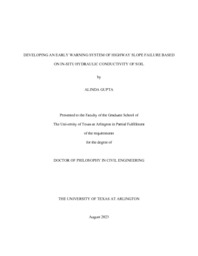
ATTENTION: The works hosted here are being migrated to a new repository that will consolidate resources, improve discoverability, and better show UTA's research impact on the global community. We will update authors as the migration progresses. Please see MavMatrix for more information.
Show simple item record
| dc.contributor.advisor | Hossain, MD Sahadat | |
| dc.creator | Gupta, Alinda | |
| dc.date.accessioned | 2023-09-27T16:30:41Z | |
| dc.date.available | 2023-09-27T16:30:41Z | |
| dc.date.created | 2023-08 | |
| dc.date.issued | 2023-08-15 | |
| dc.date.submitted | August 2023 | |
| dc.identifier.uri | http://hdl.handle.net/10106/31741 | |
| dc.description.abstract | Highway slope failure is globally a momentous issue. Highway slope failure poses a significant issue in transportation infrastructure. Several factors can contribute to slope failures, including geological conditions, weather events, and human activities. Weather events like heavy rainfall, cyclic shrinkage and swelling can trigger slope failures constructed on high plastic clays. It increases pore water pressure, causing soil saturation, and inducing failure. The consequences of highway slope failures are severe, ranging from traffic disruptions, road closures, and damage to vehicles and infrastructure, to potential injuries or loss of lives. Addressing and mitigating slope failure risks is crucial for ensuring the safety and functionality of transportation networks, as well as minimizing the economic and social impact of such events. The aim of the study is to develop an early warning system based on the hydraulic properties of regional soil. As a part of the study, two highway slope sections were selected: located over US 287 near Midlothian, Texas and beside I-20 highway near Parks Springs Blvd, Arlington, Texas. The test sites were instrumented with moisture and suction sensors to collect volumetric moisture content data and moisture suction data. These data were used to prepare field SWCC curve. In-situ hydraulic conductivity tests were performed using Mini-Disk Infiltrometer and Guelph Permeameter. In-situ hydraulic conductivity results showed 100 times higher values on surface than at two-feet depth due to surficial cracks and porous soil at the surface. The results also showed significant seasonal variation. Soil Temperature and daily rainfall data were collected from NASA POWER website. Rainfall, soil temperature and volumetric moisture content data were correlated with the hydraulic conductivity results obtained from field tests. It was observed that the hydraulic conductivity increased with the increment in each parameter. A hydraulic conductivity prediction model was developed in this study incorporating the climatic data and 85% validity of the results were found from regression analysis. This prediction model can be used to evaluate the in-situ hydraulic conductivity based on the forecasted data. An analytical study was conducted incorporating the field test data to assess the threshold hydraulic conductivity of soil for different rainfall patterns. The study showed the limiting value of hydraulic conductivity that can saturate the soil for a maximum intensity of rain. It showed that hydraulic conductivity ranged from 10-4 cm/s to 10-6 can saturate the soil and hold the moisture inside the soil and make the slope vulnerable enough to fail. The numerical study was conducted by performing both seepage and slope stability analysis incorporating the field and laboratory test data. It was observed from the output that both intensity and duration played a significant role in slope failure mechanism. A high intensity rain or any prolonged rainfall event led to a drastic change in pore water pressure which eventually reduced the shear strength of the soil and be responsible for slope failure. The seasonal variation in hydraulic conductivity was incorporated and a limiting value was assessed for different climatic conditions. A rainfall intensity-duration equation was developed with different strength and hydraulic properties (such as, volumetric water content, hydraulic conductivity) by performing a parametric study. Using the parametric study results, the threshold hydraulic conductivity was determined to obtain a factor of safety greater than 1. Finally, an early warning system of shallow slope failure was developed using the threshold value of hydraulic conductivity from analytical and numerical study. | |
| dc.format.mimetype | application/pdf | |
| dc.language.iso | en_US | |
| dc.subject | Hydraulic conductivity | |
| dc.subject | Slope failure | |
| dc.subject | Early warning system | |
| dc.title | DEVELOPING AN EARLY WARNING SYSTEM OF HIGHWAY SLOPE FAILURE BASED ON IN-SITU HYDRAULIC CONDUCTIVITY OF SOIL | |
| dc.type | Thesis | |
| dc.date.updated | 2023-09-27T16:30:41Z | |
| thesis.degree.department | Civil Engineering | |
| thesis.degree.grantor | The University of Texas at Arlington | |
| thesis.degree.level | Doctoral | |
| thesis.degree.name | Doctor of Philosophy in Civil Engineering | |
| dc.type.material | text | |
Files in this item
- Name:
- GUPTA-DISSERTATION-2023.pdf
- Size:
- 8.906Mb
- Format:
- PDF
This item appears in the following Collection(s)
Show simple item record


